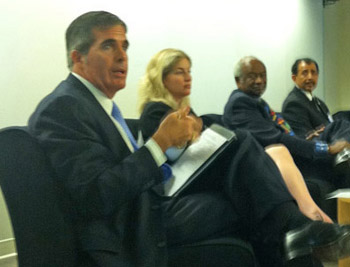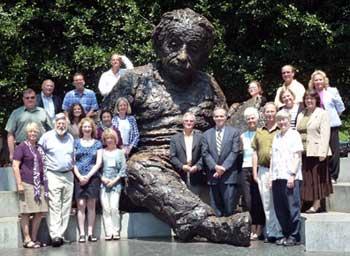The GW Virginia Science and Technology Campus was pleased to host a distinguished panel of state, regional and local political and education leaders for a discussion entitled Northern Virginia’s STEM Opportunities and Challenges: A Vertical Approach.
The event, held July 16th, was part of the inaugural GW-MIT STEM Policy Institute, a collaborative program organized by the GW Graduate School of Education and Human Development (GSHED), the Massachusetts Institute of Technology (MIT) Science and Engineering Program for Teachers and the affiliated Network of Educators in Science and Technology (NEST).
Ali Eskandarian, Dean of the GW Virginia Science and Technology Campus, provided opening comments and Paula Harper, Executive Director of Program Development and Management moderated the expert panel consisting of:
- James W. Dyke Jr., Senior Advisor, Virginia State Government Relations, McGuireWoods Consulting and Former Virginia Secretary of Education
- The Honorable Thomas A. Greason, Delegate, Virginia House of Delegates and EVP Sales at QTS
- Edgar B. Hatrick III, Superintendent, Loudoun County Public Schools
- Megan Healy, Director of STEM, Office of the Virginia Secretary of Education
- Roger Ramsammy, Provost, Northern Virginia Community College, Manassas Campus.
During the plenary session the participants were able to explore topics that examined how the Commonwealth of Virginia and its school districts are working toward college and workforce readiness in STEM fields.
Key points of discussion included:
- The recent expansion of the Northern Virginia Community College’s SySTEMic Solutions program, which was supported by work at the legislative level with key delegates and industry partners.
- How a variety of industry-education partnerships are being implemented at the district level to expand STEM education and support the Governors’ goal of substantially increasing college access and degrees for all Virginians.
- New industry trends that will be driving changes in education content and delivery throughout the region.
Participants and panelists then convened into small group sessions to further examine issues and challenges from the perspective of both political policy development and curricular delivery.
The Institute, which ran July 14-18, brought together leaders in K-12 science, technology, engineering and math content areas (STEM) to discuss policy, literacy, research and advocacy efforts. Participating teachers in the inaugural meeting came from NEST, a national fellowship of teachers working to promote STEM literacy and to enhance the professional background of K-12 teachers through the U.S. The Institute featured presentations by national experts, visits at prestigious DC research and policy advocacy associations, and engagement with policymakers on Capitol Hill.
GW-MIT STEM Policy Institute Participants Gather
Near Statue of Einstein
Additional highlights of the Institute week included meetings withThe American Association for the Advancement of Science (AAAS), The American Chemical Society, federal agency and staff members, and Congressional representatives.



